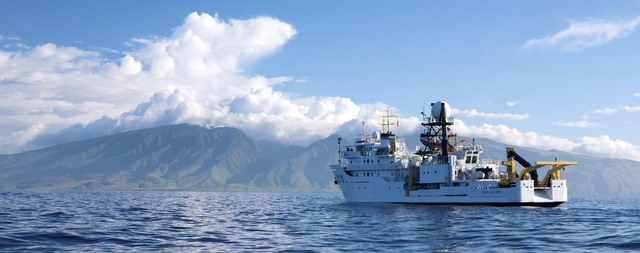KAILUA-KONA — Some West Hawaii residents may have noticed a lounging visitor off the Kona coast the past two weeks. ADVERTISING KAILUA-KONA — Some West Hawaii residents may have noticed a lounging visitor off the Kona coast the past two
KAILUA-KONA — Some West Hawaii residents may have noticed a lounging visitor off the Kona coast the past two weeks.
The vessel is the Oscar Elton Sette, a 250-foot National Oceanic and Atmospheric Administration ship, used frequently for research expeditions out of the Pacific Islands Fisheries Science Center. It’ll be hanging around Kona waters on and off through the end of October.
“The mission out right now is the (West Hawaii) Integrated Ecosystem Assessment,” said Dr. Ben Richards, who works in the stock assessment program and will lead a two-week scientific mission on the vessel beginning Oct. 13. “My research cruise is going to do the first fishery-independent survey for main Hawaiian Islands bottom fish.”
The Oscar Elton Sette is currently carrying members of the West Hawaii IEA Program, led by Dr. Jamison Gove, on a two-pronged expedition.
The first element of the research is studying the “mesopelagic boundary layer community,” which was discovered by earlier IEA expeditions and is classified on the Pacific Islands Fisheries Science Center website as a densely populated group of deep-water organisms thought to be a crucial food source for cetaceans, among other higher trophic groups.
Research is being conducted to more accurately categorize the elements of this community and understand why they prefer West Hawaii waters.
The second element of the mission is to study slicks, which appear as smooth tracts of water across the ocean’s surface due to higher water tension.
Scientists aboard the vessel are hoping to understand the ecological functions and physical mechanisms behind the slicks, which the website says “appear to function as biological oases” and “may contribute to the recruitment and retention of early life history stages of marine organisms, such as reef fish and turtles.”
When the vessel returns to port after 20 days at sea, Richards and his team will conduct final preparations for an expedition five years in the making.
Team members will deploy highly light sensitive, deep-water camera stations throughout 65 sites around the eight main Hawaiian Islands to depths of around 250 meters. The purpose will be to obtain as much information as possible on the Deep-7 — six species of deep-water snapper and one species of deep-water grouper.
The Pacific Islands Regional Office and Western Pacific Regional Fishery Management Council will combine the data compiled by Richards’ team — which will include species type, number and biological features of key fish — with socioeconomic data to determine catch limits.
Scientists will work in concert with the Pacific Islands Fisheries Group, a group of local commercial bottom fishermen, who will conduct uniform fishing at 250 sites across Hawaii.
The new, high-tech methods Richards and his team will employ could help produce the most accurate data to date. Richards said that recent stock assessments have shown the surveyed areas have not been overfished by fishermen seeking the Deep-7.



